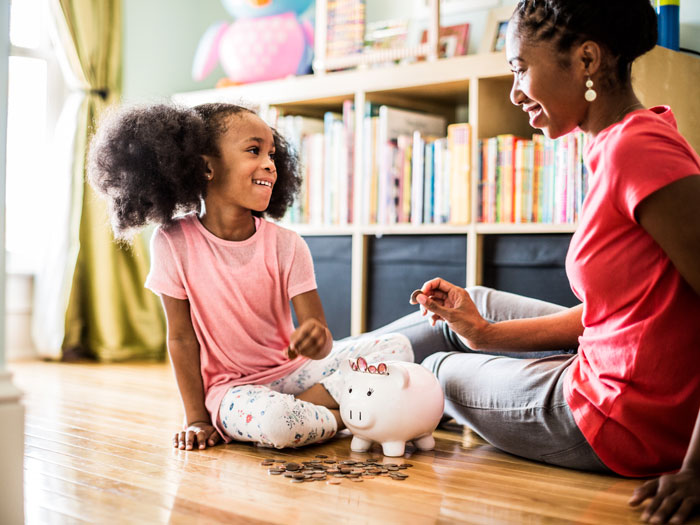
The best financial literacy lessons start early in life, experts say
 Parents have the biggest responsibility in building their children’s financial literacy foundation, experts say (Getty Images/MoMo Productions)
Parents have the biggest responsibility in building their children’s financial literacy foundation, experts say (Getty Images/MoMo Productions)
When the Ontario government announced this summer that financial literacy would be expanded in the 2020 curriculum, Michael Massoud, a CPA and principal at CPA Canada, knew that it would be a win-win for parents and children.
Massoud, who has two young children, is also active as a volunteer with CPA Canada’s Financial Literacy program.
“The early years of our kids’ lives are their formative years, and by taking the time to lay the financial foundation directly in the school system, this will help children achieve a more stable financial future,” he says.
Financial literacy might have once been called a blind spot in education, but provinces across the country have begun making it a priority in schools. And thankfully so, says Doretta Thompson, CPA Canada’s financial literacy leader.
“Financial wellness is a continuum; from knowledge, to competency, to confidence in making sound financial decisions,” she says. “Kids who learn the basics of budgeting, saving, credit, and wants versus needs, are better prepared to make good financial decisions through post-secondary education and beyond.
“And the earlier we start the more good habits we create,” she adds. “It is also about normalizing the conversation. If we start younger, we are more likely to be more open with the topic. Look at the changes sex education has had. Money is the last frontier.”
FINANCIAL LITERACY IN THE CLASSROOM
The changes to the Ontario curriculum for Grades 1-8 will increase the focus on financial management. Children will learn about currency and ways to represent different amounts of money in the younger grades; and the concept of interest rates, taxes and balancing budgets in the older grades.
“All provinces now mandate financial literacy education, but the implementation plans vary across the country,” says Thompson. “Making it mandatory is a critical first step.”
In B.C., a new provincial curriculum was introduced in 2019, in response to students who were graduating with a lack of financial skills. Alberta, too, has partnered with Enriched Academy on a pilot project this fall that will include financial education for students in grades 10 to 12.
“When we talk about money and good financial management, it goes beyond the dollars and cents that we can calculate,” says Thompson. “It’s about making choices and being aware of the trade-offs those choices require.”
Massoud says the classroom setting gives children a chance to ask and get answers to their questions about money. “How do I manage money, such as creating a budget to help me save enough to buy something I want like a toy or a video game? How does an increase in interest rates affect my mortgage? Or whether it is worth it for me to buy a toy with the money I've earned doing chores at home? These are some basic questions that we need to help our kids answer before they grow up.”
But for these lessons to be successful, teacher support will need to be addressed—something Thompson says is a critical piece missing from programming in schools. “Teachers often have very deep backgrounds in the subjects they teach, but many are uncomfortable teaching financial literacy. Some may even be struggling with their own financial management.”
SUPPORTING FINANCIAL LITERACY AT HOME
Everyone, from governments to educators, is part of the process to help build the foundation of financial literacy for kids. But, Massoud says, parents have the biggest responsibility and stake in building this foundation.
Teaching kids about money was the very first topic that CPA Canada’s Financial Literacy program covered. In 2011, the team produced the publication, A Parent’s Guide to Raising Money Smart Kids. According to Thompson, books, webinars and podcasts can help parents provide ideas and strategies to augment what they learn in class. “Be informed and know what your kids are learning,” she says. “And engage with them on what they’re learning.”
Other strategies Thompson recommends include giving an allowance to teach kids about spending, saving and giving; involving kids in the financial implications of family decisions in age-appropriate ways; and when they get their first job reviewing their pay stubs with them to make sure they understand about deductions and taxes.
“I know it can be hard for parents to teach their kids about money—I know first-hand,” says Massoud. “So the challenge for parents is, how do I make it relevant to them? Personally, I try to find opportunities in my everyday life to find ‘teachable’ moments to explain the concepts of money to my son. These moments pop up all the time in everyday activities like grocery shopping, filling up gas and even when he does simple chores like cleaning up his toys.”
JOIN CPA CANADA’S LIVE WORKSHOP
CPA Canada is offering a virtual goal setting session on Aug. 27 to teach students the value of setting S.M.A.R.T goals so they can achieve their dreams. The English Zoom will be hosted at 2:00 p.m. (EST), and the French Zoom at 3:00 p.m. (EST).
Click here to learn more about CPA Canada’s Financial Literacy program and gain access to free resources on a number of financial literacy topics.